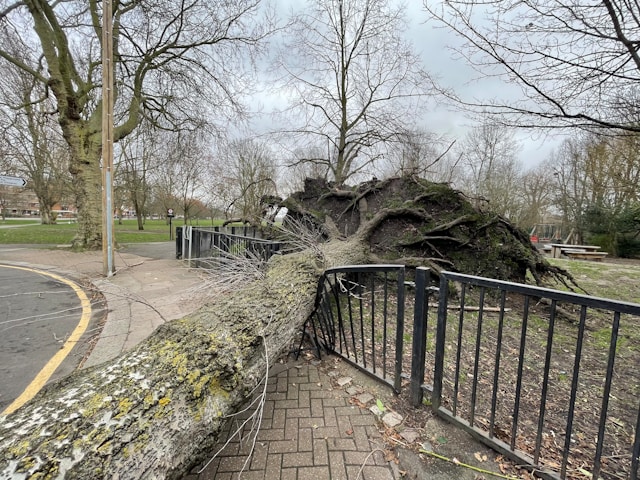
Domestic violence is a complex and widespread public health problem in the United States, with many costs to society. Since the passing of Pennsylvania’s Protection from Abuse Act in 1977, every state has made significant improvements to recognize and respond to the problem of domestic violence (Buzawa et al., 2017; Klaw & Scherf, 1993), however, the problem persists and at higher rates, ironically, in the families of those charged with policing the problem. Celeste Hedequist, who holds a J.D. from Boston University School of Law and an M.P.H. for Columbia University School of Public Health, attempts to address the dichotomy of domestic violence and police families.
Hedequist explains that despite such improvements, the Centers for Disease Control and Prevention (CDC) indicates that one in four women will still experience physical violence by their intimate partner at some point during their lifetimes, with intimate partner violence occurring in over ten million people each year (Heucker et al., 2021). “Domestic violence affects people of all ethnic, socio-economic, and educational backgrounds, including law enforcement professionals” (Russell & Pappas, 2018). The stakes remain high for victims and society, and the efforts beginning in the 1970s to eradicate the problem continue to persevere today. Many amendments to domestic violence laws have been enacted and new policies have been implemented underscoring the complexity and dynamic nature of the domestic violence problem in the United States (Klaw & Scherf, 1993).
Adding further complexity to this already intricate societal issue is the dichotomy of domestic violence within police families. On the one hand, it’s been reported that police are at a heightened risk for committing domestic violence, and on the other hand they are tasked with enforcing the laws that protect against it. Many similarities in cultural constructs and belief systems between the military and police departments may explain similarities in greater number of potential risk factors for domestic abuse within both subpopulations (Shewmaker & Shewmaker, 2014; Goodmark, 2017). While empirical data is sparse, independent investigations of police departments and some earlier studies indicate that domestic violence is pervasive within police families and is significantly under-reported and under-enforced (Goodmark, 2017). The issue of violence within police families has recently received further attention as an important societal issue in need of more in-depth scrutiny. The reasons appear two-fold. First, police families are deserving of protection from domestic violence, just like non-police families. Second, society also deserves laws and interventions that do not pose a risk of re-victimization. An overview of the literature of officer-involved domestic violence (OIDV) highlights these reasons. A discussion follows attempting to digest the dichotomy of how those chosen to safeguard battered women are simultaneously, and ironically, at elevated risks for battering them.
To address this dichotomy, we must explore why police officers might resort to violent and coercive behaviors towards their spouses, and determine how best to prevent this problem, while also considering alternatives to using the criminal justice system, and thus police power to address the problem of domestic violence generally.
Prevalence
Scholars have struggled to estimate with accuracy the prevalence of domestic violence within police families. “An often-repeated statistic is that 40% of police families experience domestic abuse” (Huckabee, 2021). Typically, when asserting 40% as the estimate, scholars have relied on an older landmark study conducted in 1991 which required officers to self-report their abuse (Johnson, 1991). The measure of violence used in the study conducted was a questionnaire which asked police officers whether they had behaved violently toward their spouse or children in the six months prior to the survey. There is another landmark study by Neidig et al. (1992) which suggests that the rate is somewhere between 20%-40%, or twice to four times the rate of the general population. While outdated and limited, these studies are based on primary sources, and thus, still typically provide the basis for estimates of rates of domestic violence within police families.
There are obstacles to addressing OIDV that make empirical data more difficult to obtain which are discussed in the paragraphs below. However, most researchers still contend that domestic violence within police families happens at elevated rates compared to non-police families, and the rate of 20%-40% seems to be most frequently quoted in the literature. Regardless, “[g]iven the tools with which the state arms police officers, even those lower rates of abuse should be reason enough for real concern” (Goodmark, 2015, pg. 1196).
Belief-Systems and Cultural Constructs Underlying OIDV
Celeste Hedequist explains that there are belief systems and cultural constructs within law enforcement agencies which make it vulnerable to issues of domestic violence. The culture of law enforcement is male-dominated, often stressing the use of force and aggression (Goodmark, 2015). “[T]he notion of what it means to be a police officer is now firmly embedded in the context of militarized masculinity…” (Goodmark, 2015, pg. 1217). With the use of uniforms, weapons, and exerting control as a means of problem solving, it’s easy to see how the risk factors for those in the military would also apply to law enforcement. As Shewmaker and Shewmaker (2014) illustrate, the increased stress associated with occupational demands, as well as mental health and substance abuse issues in the military often manifest through incidence of family violence. Studies show this is also true about the families of law enforcement officials (Anderson & Lo, 2011; Voilanti, 2007).
Police officers are trained to dominate physically and psychologically through intimidation and posturing (Anderson & Lo, 2011). Many of these tactics can be used to gain control in all circumstances, making it difficult to turn off the use of them at home (Anderson & Lo, 2011). Also, repeated exposure to conflict in which aggressive force is used by an officer may cause the officer to respond more aggressively to perceived threats, a symptom of Post-Traumatic Stress Disorder (PTSD) noted in military families due to similar circumstances (Shewmaker & Shewmaker, 2014). A study conducted using data from the Baltimore Police Stress and Domestic Violence underscores the following: “Police officers are confronted repeatedly with gruesome realities that most citizens will not encounter in a lifetime. Stressful and potentially life-threatening events officers experience may include the violent death of a patrol partner, the taking of a life in the line of duty, an arrest that turns violent, or the viewing of atrocious crime scenes” (Anderson & Lo, 2011, pg. 1177).
It’s not difficult to see how a persistent level of increased stress like this could result in mental health problems, such as PTSD, and substance abuse issues compounding anger and aggression. The same study (Anderson & Lo, 2011) also notes that a lack of administrative and public support puts officers at greater risk of experiencing severe stress. Additionally, a disparaging public perception of the police is not helpful, as it likely results in negative self-beliefs, as well.
Additionally, excess alcohol consumption is a lifestyle among law enforcement (Violanti, 2007), and the effects of alcohol on domestic violence have been well-studied. Over half of the battered women in one study (Walker, 1979) reported a relationship between alcohol and battering, and the most violent physical abuse typically occurred when men were consistent drinkers. Violanti (2007) looked at homicide-suicide in police families and ascertained that certain traumatic police force work exposures increased the risk of PTSD, which subsequently increased the risk of high alcohol use. An earlier research study found that as high as “48% of their male and 40% of their female police officers were drinking alcohol to excess” (Violanti, 2007, pg. 99). Thus, this common lifestyle among officers in which consuming excess alcohol is used to diminish stress has serious implications, especially considering most officers have access to firearms.
Police officers often exhibit the authoritarian personality which has been described by Anderson and Lo (2011) as violent and suspicious, while having little patience for anyone who does not submit. Although very few studies have addressed this trait, the few that have found “a significant correlation between authoritarianism and domestic violence within families of male and female police officers alike” (Anderson & Lo, 2011, pg. 1178). When authoritarian spillover and negative emotions produced by stress were present in a high degree, that same study states it may explain the aggression some officers display towards intimate partners (Anderson & Lo, 2011). Consequently, this authoritarian personality trait amongst law enforcement might also fuel beliefs about women as less powerful and easier to manipulate.
It’s common knowledge that police operate in a somewhat clandestine environment. This secretive nature of the force contributes to the risk that domestic violence within it will be under-reported and under-enforced against police officers. An essay by sociologist Thomas Nolan (2009) summarizes this sentiment: “[m]uch has been reported in the media and depicted in the popular culture that purports to describe the so-called ‘Blue Wall of Silence,’ a phenomenon that suggests that the police engage in a pervasive pattern of deception and withholding of the truth in ritual cover-up for their brethren.”
This suggests a common way of thinking amongst officers regarding the law and whether or not it applies to them. The blue wall of silence is a social construct that serves as a dense barrier to addressing the problem of domestic violence within police families in meaningful ways.
Assessment of Law
At the national level, the Violence Against Women Act (1994) defines domestic violence as a “national crime problem,” and included amendments to federal law that expanded protections for victims and created grant programs to states to increase enforcement and prosecution of domestic violence crime (Stinson & Liederbach, 2013, pg.1).
The Violence Against Women Act makes it a federal crime to cross state lines to commit domestic violence or leave the country violating a protective order (Huecker et al., 2021). In 1996, Congress enacted the Lautenberg Amendment to the federal Gun Control Act which “prohibits individuals—including police officers—from owning a gun or using a firearm if they have been convicted of a misdemeanor crime of domestic violence” (Stinson & Liederbach, 2013, pg. 2). Reports and convictions of this kind against officers carry the potential consequence of the loss of their gun and possibly their job. Consequently, this might be a consideration for why such abuse within police families is under-reported, and why the brotherhood of police officers protects one another so fiercely.
At the state level, Massachusetts has adopted a mandatory arrest approach requiring that the police must arrest whenever probable cause exists (Mignon & Holmes, 1995). Interestingly, Mignon and Holmes (1995) also found that upon the passage of the mandatory arrest law, less experienced officers make arrests more often. While that study found an alternative explanation for this phenomenon, the lack of sufficient judgment exercised by younger officers brought into question whether inexperienced officers have more trouble deciphering the victim from the perpetrator.
Massachusetts has passed other laws to address the problem of domestic violence generally. A violation of these laws is considered a crime which cannot be dropped by the victim in many cases, such as with M.G.L. Ch. 209A, which covers protective orders in the domestic realm. While these laws and protection orders apply in the context of domestic violence within police families, given the nature of the situation, these can easily be evaded. First, victims of domestic violence within police families are “hesitant to report the crime because they fear retaliation in the form of further abuse from their spouse and worry that their complaints will not be taken seriously” (Cheema, 2016, pg. 488). Second, law enforcement officers typically know the laws and the loopholes in them. Oftentimes, officers also personally know the players in the criminal justice system, such as the prosecutors in the local District Attorney’s Office, court clerks, court magistrates, judges, and the local defense attorneys. Also, law enforcement officers have significant advantages when it comes to their word because many people have an ingrained respect for police authority. Compounding matters are issues of corruption and conflicts of interests within the legal system, because the blue wall of silence can further work to conceal evidence against the officer or assist those officers in attempting to delegitimize their spouses.
While there are some community-based programs and shelter options available to domestic violence victims generally, these are not often possible options for victims of domestic violence in police families. As one scholar writes, “[b]ecause officers are trained to connect people subjected to abuse with the resources meant to protect them, they are often familiar with shelters and other service providers in the community” (Goodmark, 2015, pg. 1198). Also, in some instances, a shelter’s address is kept secret from the spouse of an abusive officer, and some victims are prevented from entering shelters either because of her status as an officer’s wife or because requirements for entry are too burdensome for some women (Goodmark, 2015).
Some states have recognized this problem and have enacted OIDV-specific policies in order to encourage law enforcement agencies to follow such guidelines (Cheema, 2016). However, Massachusetts has not yet adopted such legislation. In December of 2020, the Massachusetts Legislature passed a police reform bill with numerous initiatives, including a new civilian-led commission that will be able to certify or decertify officers while overseeing investigations of any alleged misconduct (Fischer, 2020, pg.1; An Act Relative to Justice, Equity and Accountability in Law Enforcement in the Commonwealth, Chapter 253 of the Acts of 2020). As the author notes, “the legislation falls short of fully limiting qualified immunity for certified officers, however, officers are now under a duty to intervene in cases of excessive force or misconduct by a fellow officer” (Fischer, 2020, pg.1; An Act Relative to Justice, Equity and Accountability in Law Enforcement in the Commonwealth, Chapter 253 of the Acts of 2020). The commission can also decertify an officer for violating a person’s civil rights (Fischer, 2020). Perhaps these changes to legislation in Massachusetts will begin to curb the problem of domestic violence generally and within police families. The formation of this civilian-led commission will allow a more objective option to pursue than the legal system and a better option than an internal affairs department at a local police department, where the victim’s husband is likely employed or has friends stationed. However, the make-up of members and the integrity of the commission will be critical to its future success.
In addition, it should be noted that the Assistance for Department of Correction Employees, Retirees, and their Families in Massachusetts recognizes on their webpage that the rate of domestic violence in law enforcement families is estimated to be two-to-four times higher than that of the general public (Mass.gov, Domestic Violence Office, n.d.). This program offers some assistance to families of law enforcement. The webpage has a phone number and additional resources and services listed. The downside is that a law enforcement officer will typically field calls placed to the number provided.
Discussion and Future Recommendations
To determine how best to prevent the problem of domestic violence within police families, one must not only consider the causes of it, but also consider alternatives to using police power to address domestic violence generally. OIDV not only harms police families, but it destroys the overall integrity of the criminal justice system. De-escalating the domestic disputes of others should require less force and aggression in most instances; not more. However, as noted above, most officers are trained to use force and coercive methods to dominate situations, and some use alcohol excessively and have mental health issues due to the ardent nature of their work. These risk factors are synergistic such that the combined effect of them enhances the risk of severe violence and lethality, especially given that most police have access to firearms. The militaristic nature of policing in the United States and the fact that police forces are heavily dominated by men, while women are still at higher risk to be abused in domestic partnerships, makes the extensive use of police power a flawed solution to the problem of domestic violence (Buzawa et al. 2017).
Another frustrating circumstance within the criminal justice system is the reality of protective orders. These orders can be issued with very little evidence and are subject to abuse. Therefore, they can increase the likelihood that victims of domestic violence, especially those within law enforcement families, will be re-traumatized by the very system that is supposed to protect them. One consideration for state legislatures is to make protective orders reciprocal, so that they would apply to both parties. This would diminish the rate of improperly seeking one to be used as a sword rather than a shield. Violations of protective orders are also easy to fabricate, as an alleged prohibited contact could potentially include many things that are not an intended contact, including internet-based communications such as social media. This may lead to improper arrests and wrongful sentencing of true victims in intimate relationships, and it could foreseeably cause victims to lose faith in the criminal justice system.
Given that the problem of domestic violence remains unsolved regarding recourse through the criminal justice system, it begs the question: Why use it so extensively? “Some scholars, advocates, and activists believe that the harms of criminalization are significant enough to justify curtailing the use of the criminal justice system in cases of intimate partner violence” (Goodmark, 2017, pg. 60) Goodmark goes on to discuss alternatives to criminalization, such as forms of social control to reduce the incidence of behavior to a socially acceptable rate through less coercive means. Restorative justice focuses on harm rather than crime and seeks a collaborative process to hold perpetrators accountable (Goodmark, 2017). Community-based alternatives exist and should be explored in the future, either supplementally or as an alternative to the criminal justice system. Police power in the current framework and the culture of law enforcement is simply too fraught with risk factors to make further meaningful impact on domestic violence, especially within police families.
Moreover, repeated exposure to domestic violence may increase an officer’s own risk of domestic violence at home, and thus further perpetrate traditional cycles of male dominance and abuse of women within intimate relationships. Male officers who are prone to aggression will likely identify more with the aggressor, whether intentionally or unintentionally, and this cost to society far outweighs the benefit of using police power extensively—which many victims refuse to seek help through, anyhow. Also, policing should not be to an officer’s detriment. Risk factors, such as alcohol use, increased stress levels, hyper-masculinity, a need to dominate and control, and the lack of women in police forces are all associated with OIDV and must be better addressed before progress can be made.
Some scholars suggest mandatory counseling for all sustained complaints involving domestic violence (Violanti, 2007). Others advocate for dismantling the code of silence amongst police officers. “Officers will increasingly hesitate to report other officers for domestic violence because such officers will lose their jobs” (Violanti, 2007). Perhaps it is time to reconfigure police departments based on addressing risk levels, so that opportunities for employment still exist if an officer involved in domestic violence loses his right to carry a firearm. There are many alternatives available, and some may need testing for safety and effectiveness before meaningful progress is seen.
Final Thoughts
Domestic violence within police families deserves more attention. When a police officer misuses institutional power, that officer erodes public trust. A police culture that fosters silence in the face of misconduct needs to be eradicated, and until this is the case, police power should not be used extensively to meet the needs of victims of domestic disputes, or in some cases, community disputes in general. Further, law enforcement officers should have the resources they need to proactively combat the stress of their work so there is no spillage into their home. Domestic violence within police families deserves the same attention and level of intervention as non-police families, and sometimes more, as police officers serve the public and many of them put their lives in danger for the good of the community. Some scholars believe that the adoption of OIDV policies by local police agencies will work if they mandate crime reports in every instance of OIDV and treat officers as they would any other citizen (Violanti, 2007), but there are unique and inherent risk factors with police work which should not go unaddressed. These risk factors must be studied more closely and ultimately mitigated completely so as not to further inflict harm on police families and society overall.
About Celeste Hedequist:
Celeste Hedequist is a lawyer and advocate in Massachusetts. As a self-motivated individual, and someone who values education, Celeste holds a Bachelor’s of Science in Biology from Boston College, a Master’s of Public Health in Environmental Sciences from Columbia, and a Juris Doctor from the Boston University School of Law. She combines her passion for law, advocacy, and the environment to assist in opportunities locally and abroad.
Alongside her professional achievements, Celeste is also an avid traveler and has ventured across the United States and various parts of the globe with her husband and children. Her travel blog recounts her family’s experiences with the different people and cultures they have encountered on their visits.
References:
An Act Relative to Justice, Equity and Accountability in Law Enforcement in the Commonwealth, Chapter
253 of the Acts of 2020.
Anderson A.S., & Lo, C.C. (2011). Intimate partner violence within law enforcement families. Journal of
Interpersonal Violence, 26(6), 1176-1193.
Buzawa, E., Buzawa, C., & Stark, E. (2017). Responding to Domestic Violence: The Integration of
Criminal Justice and Human Services (5th ed.), Thousand Oaks, CA: Sage Publications.
Cheema, R. (2016). Black and blue bloods: Protecting police officer families from domestic violence.
Family Court Review 5 (3), 487-500.
Fischer, M. (2020) Massachusetts legislature approves major police reform bill in aftermath of George
Floyd killing, Jurist. http://link.gale.com/apps/doc/A644123876/ITOF?u+las&xid+85ea4358
Goodmark, L. (2015). Hands up at home: Militarized masculinity and police officers who commit intimate
partner abuse. 215 Brigham Young University Law Review, 5, 1183-1246.
Goodmark, L. (2017). Should domestic violence be decriminalized? Harvard Journal of Law and Gender,
40, 53-114.
Huckabee, T. (2021, October 11). Do 40 percent of police families really experience domestic abuse?
Relevant Magazine. https://www.relevantmagazine.com/current/nation/do-40-percent-of-policefamilies-really-experience-domestic-abuse/
Huecker, M.R., King, K.C., Jordan, G.A., & Smock, W. (2021). Domestic Violence. Treasure Island, FL.,
StatPearls Publishing. Last retrieved October 28, 2021, from https://www.ncbi.nlm.nih.gov/books/NBK499891/
Klaw, M. & Scherf, M. (1993). Feminist Advocacy: The Evolution of Pennsylvania’s Protection from Abuse Act, University of Pennsylvania Journal of Law & Soc. Change, 1, 21-37.
Mignon, S.I. & Holmes, W.M. (1995). Police response to mandatory arrest laws. Crime and Delinquency,
41(4), 430-442.
Neidig, P.H., Russell, H.E., & Seng, A.F. (1992). Interspousal aggression in law enforcement families: A
preliminary investigation. Police Studies, 15(1), 30-38.
Russell B.L, & Pappas N. (2018). Officer involved domestic violence: A future of uniform response and
transparency. International Journal of Police Science & Management, 20(2), 134-142.
Shewmaker, P. & Shewmaker, S. (2014). Military nuances in domestic violence cases. American Journal of
Family Law, 28, 25-30.
Stinson, P.M., & Liederbach, J. (2013). Fox in the henhouse. A study of police officers arrested for crimes
associated with domestic violence and/or family violence. Criminal Justice Policy Review, 24(5), 601-625.
Violanti, J. (2007). Voilanti, J. (2007). Homicide-suicide in police families: aggression full circle.
International Journal of Emergency Mental Health, 9(2), 97-104.
Walker, L.E. (1979). The Battered Woman, New York, New York: Harper & Row, Publishers, Inc.
Written by – Celeste Hedequist
Published by – Christina Shrier





